It’s the Christmas season, so I thought I’d try something a little different: a Fabric of Paris quiz. There are twenty questions, one for each arrondissement. It’s not intended to be easy: if you score 10 or more, well done! If you score 15 or more, would you like to write for Fabric of Paris?
I’ve gone with the low-tech option of letting you calculate your score yourself. The answers are at the bottom of the page; if you prefer to reveal the answer after each question, there are links to help you jump between the two sections. With plenty of gaps to prevent spoilers.
Without further ado, let’s start the quiz. Best of luck!
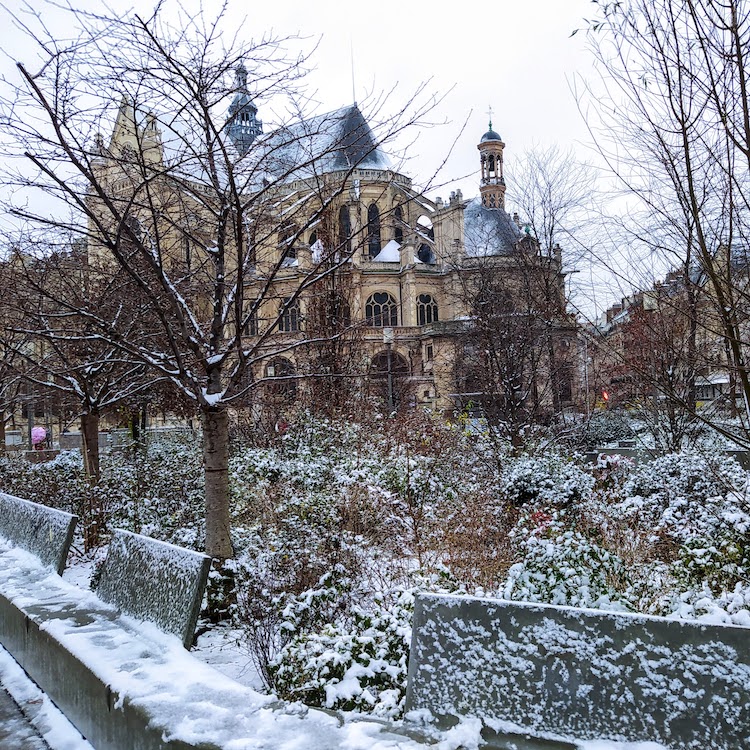
1. The 16th-century church of Saint-Eustache looks over a park named for which African resistance leader?
2. Which pretender to the throne of England gives her name to a street in the 2nd arrondissement?
3. Which museum in the 3rd arrondissement occupies the priory of Saint-Martin-des-Champs?
4. The Place des Vosges, known for its magnificent porticoes, has long been a popular destination for locals and tourists alike. Which king is honoured there by an equestrian statue in the middle of the square?
5. The 5th arrondissement is known as the home of the Latin Quarter, a district famous for its student population and culture. How did the neighbourhood get its name?
6. Which national body is based in the Luxembourg Palace, adjacent to the gardens of the same name?
7. Designed by French architect Marc Mimram, the footbridge linking the National Assembly and the Tuileries Gardens is named after which African president?
8. Situated at the northeastern edge of the 8th arrondissement, Liège station on metro line 13 was once known by a different name. What was it called before, and why did it change?
9. Opened on the same day, metro lines 7 and 12 pass within 150 metres of each other in the 9th arrondissement, but there’s no interchange because the two lines were opened by rival companies. Name either of the stations at this closest approach.
10. Which park next to the Canal Saint Martin was once touted to be a tunnel entrance and motorway interchange, as part of a highway plan for Paris that would have seen the canal filled in?
11. Which traffic circle and transport hub was once known as the Place du Trône (“Throne Square”)? During the Revolution, it was renamed Place du Trône-Renversé (“Overthrown Throne Square”); it took its current name in 1880.
12. The largest clock faces in Paris are located in the 12th arrondissement. Which building do they adorn?
13. Which two tram lines meet at the Porte de Choisy?
14. Which park in the 14th arrondissement was designed by Adolphe Alphand during the reign of Napoleon III? He also laid out the Buttes-Chaumont and numerous garden squares around the city.
15. Which singer-songwriter, who died in 1981, gave his name to a park opened in the 15th arrondissement in 1985?
16. Which street, a prestigious address lined with luxurious private residences, is the widest in Paris?
17. The 17th arrondissement is home to the only mainline railway station in Paris that isn’t a terminus. What’s it called?
18. Which French civil war was sparked by a dispute over control of cannons on the Montmartre hill?
19. The only RER station in the 19th arrondissement is named for which American hero?
20. Which statesman of the Third Republic gives his name to a metro terminus in the 20th arrondissement?
Before I reveal the answers, let’s take a brief interlude to look at some scenes from recent Parisian Christmases…
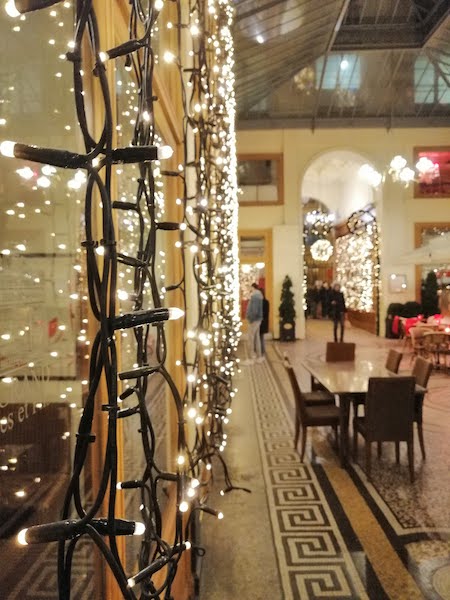
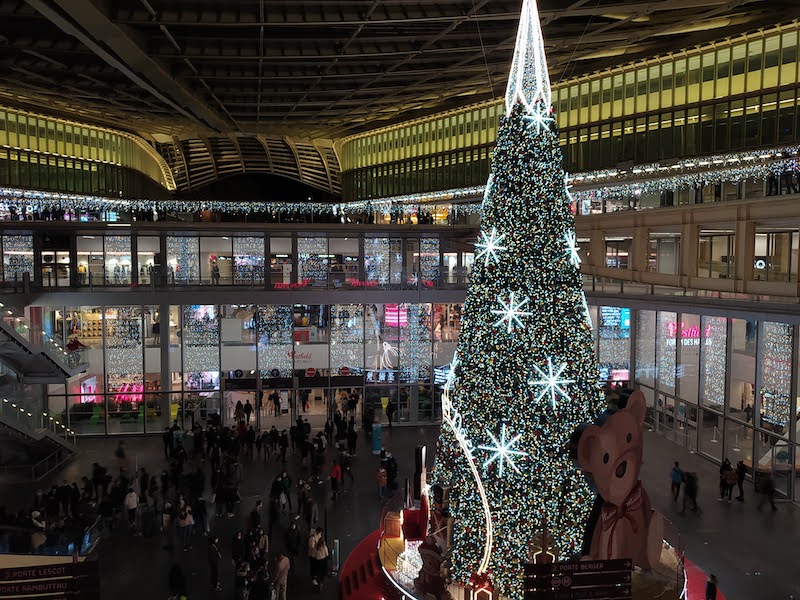
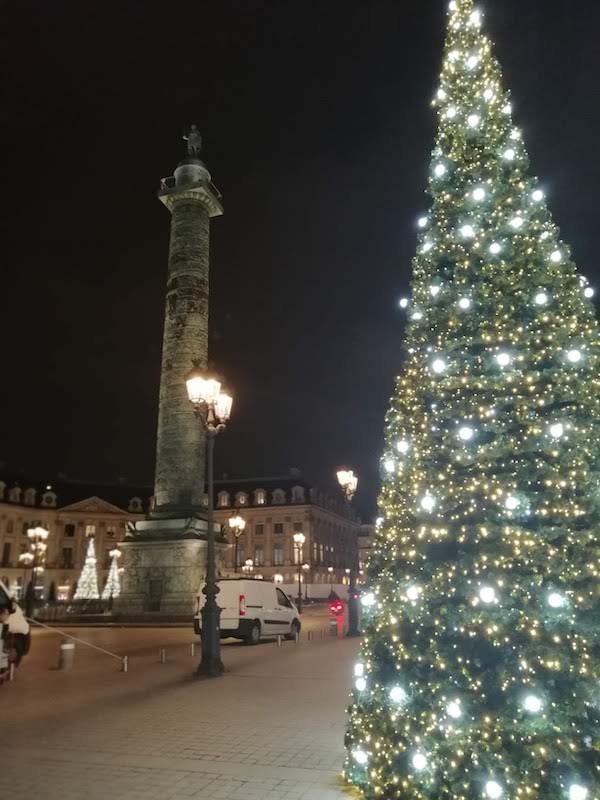
1. The 16th-century church of Saint-Eustache looks over a park named for which African resistance leader?
The answer: Nelson Mandela
In the 2010s, the area of Les Halles was the subject of major redevelopment. On the eastern side, the Forum des Halles shopping centre welcomed a new glass canopy. To the west, the Bourse du Commerce was redesigned as a museum. To the north, the southern façade of the church of Saint-Eustache was restored. And in the middle, the park was redesigned. When South African statesman Nelson Mandela died in December 2013, the Council of Paris voted to rename this new garden in his honour.
2. Which pretender to the throne of England gave her name to a street in the 2nd arrondissement?
The answer: Mary, Queen of Scots
The story of the name of the rue Marie Stuart is a fun one. So much so that I’ve told it twice on this blog.
3. Which museum in the 3rd arrondissement occupies the priory of Saint-Martin-des-Champs?
The answer: Arts et Métiers
In the Early Middle Ages, long before the present-day 3rd arrondissement belonged to the city of Paris, a monastery was founded here, dedicated to St Martin of Tours. In the later medieval period, this became an important priory. During the French Revolution, the buildings were seized, with some torn down and others used as a prison. But in 1802, a museum and higher education institute opened at the site. The church and refectory, dating to the 13th century, are now occupied by the Musée des Arts et Métiers. If you’ve ever wondered what an aeroplane would look like inside a church, wonder no more: you can visit the museum instead.
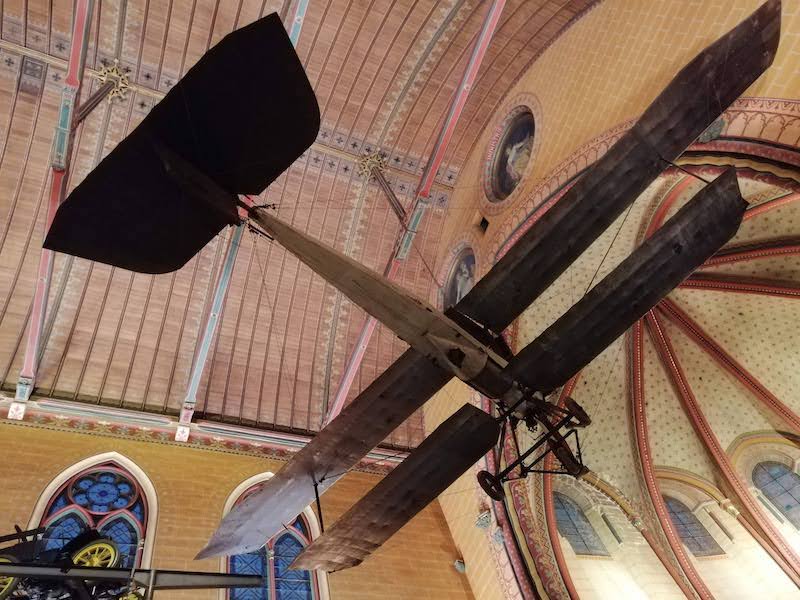
4. The Place des Vosges, known for its magnificent porticoes, has long been a popular destination for locals and tourists alike. Which king is honoured there by an equestrian statue in the middle of the square?
The answer: Louis XIII
The Place des Vosges is the oldest square in Paris, dating to 1612. Originally called the Place Royale, it was opened during the early years of the reign of Louis XIII, in honour of the eleven-year-old’s engagement to Anne of Austria. It took its current name during the Revolution, when the first statue of Louis, dating to 1639, was destroyed. The current statue was erected in 1821, during the Restoration.
5. The 5th arrondissement is known as the home of the Latin Quarter, a district famous for its student population and culture. How did the neighbourhood get its name?
The answer: the university
The Latin Quarter, which spans the 5th and 6th arrondissements but has its heart in the 5th, is the site of a number of vestiges of the Roman city of Lutetia. But that’s not where it got its name. Since the foundation of the University of Paris in at least 1150, the area around the Sorbonne has been a seat of learning. Since teaching was long conducted in Latin, 17th-century writers took to calling the neighbourhood the pays latin (“Latin country”) – a playful use of a term for the Italian region of Latium. In time, this morphed into the modern term: the quartier latin.
6. Which national body is based in the Luxembourg Palace, adjacent to the gardens of the same name?
The answer: the Senate
The Luxembourg Palace was originally built as the royal residence of Marie de’ Medici, mother of Louis XIII. Since the Revolution, it has been the seat of the various upper houses of the French national parliament. Today, that means the Senate.
7. Designed by French architect Marc Mimram, the footbridge linking the National Assembly and the Tuileries Gardens is named after which African president?
The answer: Léopold Sédar Senghor
The Passerelle Solférino was inaugurated in 1999. Its ingenious construction makes use of two decks which connect to the upper and lower riverbanks at either side. In 2007, to mark the centenary of the birth of the first Senegalese president, the bridge was given its current name. The Passerelle Léopold-Sédar-Senghor is one of my six favourite bridges over the Seine in Paris.
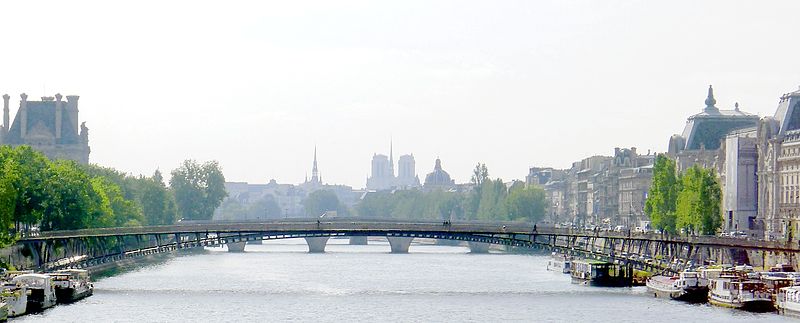
8. Situated at the northeastern edge of the 8th arrondissement, Liège station on metro line 13 was once known by a different name. What was it called before, and why did it change?
The answer: Berlin
Berlin station, named after an adjacent street, opened in February 1911. Three years later, France was at war with Germany, and the station was renamed to distance itself from the German capital, and to honour the resistance of Liège in the first battle of the war. Similarly, the avenue d’Allemagne (“Germany Avenue”) was renamed after Jean Jaurès, the socialist hero assassinated at the outbreak of the war, and its namesake metro station became Jaurès.
9. Opened on the same day, metro lines 7 and 12 pass within 150 metres of each other in the 9th arrondissement, but there’s no interchange because the two lines were opened by rival companies. Name either of the stations at this closest approach.
The answers: Le Peletier (line 7) and Notre-Dame-de-Lorette (line 12)
While most of the Paris metro was built by the CMP (Compagnie du chemin de fer métropolitain de Paris), lines 12 and 13 of the Paris metro were built by rival Nord-Sud. In addition to the missed opportunity here, line 12 also misses a convenient connection at Havre-Caumartin. Further north, where it crosses line 4, two stations were later merged with a long corridor at Marcadet-Poissonniers.
10. Which park next to the Canal Saint Martin was once touted to be a tunnel entrance and motorway interchange, as part of a highway plan for Paris that would have seen the canal filled in?
The answer: the Jardin Villemin
The Jardin Villemin occupies the site of a disused military hospital. It’s a lovely green space in a part of town with precious few parks. But it almost never happened, as the site was earmarked for an interchange between an underground motorway from the Gare Saint-Lazare and a north-south road that would have occupied the canal. Find out more in my article on the subject. And to find out about a misguided motorway that did get built, see my recent post about the boulevard périphérique.
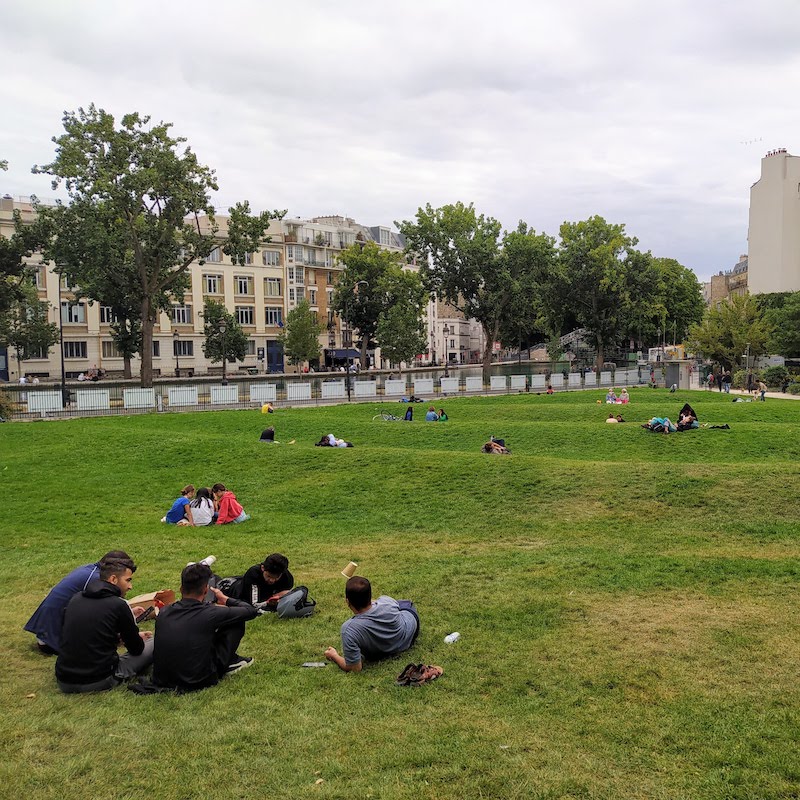
11. Which traffic circle and transport hub was once known as the Place du Trône (“Throne Square”)? During the Revolution, it was renamed Place du Trône-Renversé (“Overthrown Throne Square”); it took its current name in 1880.
The answer: the Place de la Nation
In 1880 – a decade after the declaration of the Third Republic, the first durable republic in French history – 14 July was celebrated as the national day for the first time. To mark the occasion, the Place du Trône was renamed after the French nation.
12. The largest clock faces in Paris are located in the 12th arrondissement. Which building do they adorn?
The answer: the Gare de Lyon
The clock tower of the Gare de Lyon was erected in 1900, when the station was rebuilt to mark that year’s Universal Exposition. Each clock face measures 6.4 metres. Each hand weighs 38 kg.
13. Which two tram lines meet at the Porte de Choisy?
The answer: 3a and 9
Tramway interchanges were once a common sight in Paris, but today there are only two within the city walls. Line 3a connects with line 2 at Porte de Versailles, and with line 9 at Porte de Choisy. It’s a good opportunity to see two different generations of Alstom Citadis trams.
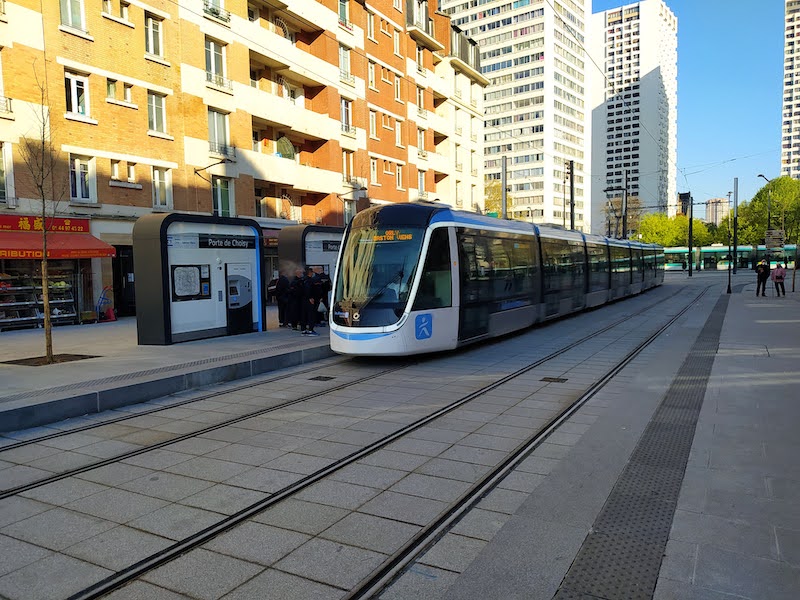
14. Which park in the 14th arrondissement was designed by Adolphe Alphand during the reign of Napoleon III? He also laid out the Buttes-Chaumont and numerous garden squares around the city.
The answer: Montsouris
The “renovation” of Paris by Baron Haussmann in the 1860s is largely responsible for Paris as we know it today. One of the key new features was a number of new parks and garden squares, designed by director of works Adolphe Alphand. Of particular importance were the “woods” of Vincennes and Boulogne, and the parks of Buttes-Chaumont and Montsouris. Laid out in the English style, with artificial lakes, hills, and grottoes, they are popular destinations today.
15. Which singer-songwriter, who died in 1981, gave his name to a park opened in the 15th arrondissement in 1985?
The answer: Georges Brassens
One of the greatest French poets and musicians of the 20th century, Georges Brassens lived much of his life in the southern districts of Paris. He spent twenty-two years in a small house in the 14th arrondissement with no hot water or electricity, which he shared with an older couple. Later, he moved across the boundary into the 15th, some 200 metres from the slaughterhouses which would ultimately become a park bearing his name.
16. Which street, a prestigious address lined with luxurious private residences, is the widest in Paris?
The answer: Avenue Foch
Including the gardens that line it for the entirety of its 1.3 km length, the avenue Foch measures a staggering 120 metres in width. The footpath between the road and the gardens is unpaved, which once allowed horseriders to use it to reach the Bois de Boulogne. Famous residents have included members of the Saudi and Monégasque royal families, along with Rothschilds and Assads. Claude Debussy, Prince, Grace Kelly and Jeffrey Epstein also once lived here.
17. The 17th arrondissement is home to the only mainline railway station in Paris that isn’t a terminus. What’s it called?
The answer: Pont Cardinet
Opened in 1854 and rebuilt in 1922, the Gare de Pont Cardinet was neglected during the second half of the 20th century, finally closing to passengers in 1996. But in the new century, the district has been undergoing major regeneration, with a park and a number of new buildings replacing the freight yards which once stood there. Today, suburban trains from Transilien line L stop at the station, where, since 2020, passengers can connect with metro line 14. Two new bridges have also been added in the last several years, to connect the buildings on either side of the railway.
18. Which French civil war was sparked by a dispute over control of cannons on the Montmartre hill?
The answer: The Paris Commune
After the French surrender to the Prussians in 1871, the newly elected, conservative government tried to seize control of cannons stationed in Paris. When they reached the Butte Montmartre, they met with a hostile crowd. Before long, the government had withdrawn from the capital altogether. In its absence, the city was governed as the Paris Commune, a revolutionary era that lasted two months and inspired future generations of communists, socialists and anarchists the world over.
19. The only RER station in the 19th arrondissement is named for which American hero?
The answer: Rosa Parks
Rosa Parks RER station opened in December 2015, adding a stop on line E to serve the northeastern corner of Paris. But a tram stop by the same name had already been open at the site for three years. An extension to tram line 8, due in 2030, will make this multimodal transport hub even more important. A fitting tribute for the civil rights activist best known for her bus-based defiance.
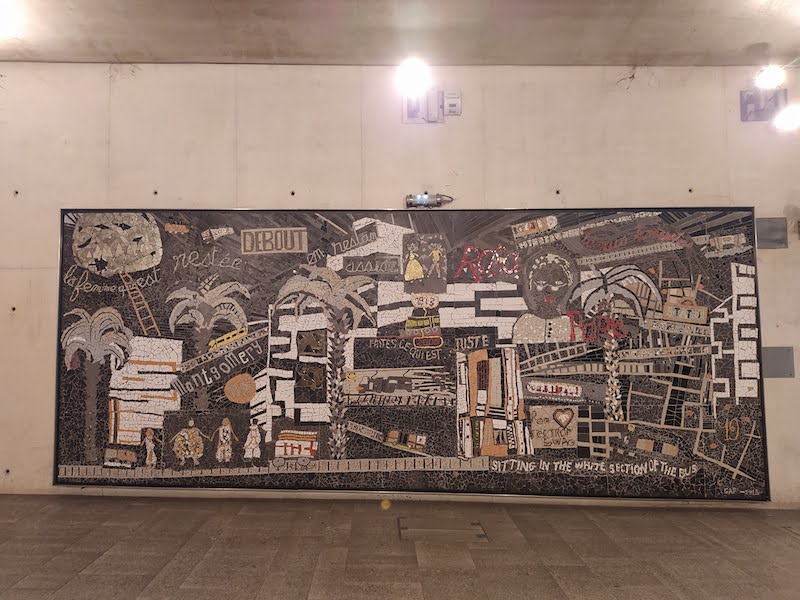
20. Which statesman of the Third Republic gives his name to a metro terminus in the 20th arrondissement?
The answer: Léon Gambetta
A vocal critic of the monarchy of Napoleon III, Léon Gambetta is best known for declaring the Third Republic in September 1870. He went on to serve in the Government of National Defence until the French surrender, and later served as a member of parliament for the 20th arrondissement of Paris. In 1882, after a brief stint as prime minister, he died at the age of 44. Gambetta metro station, where line 3 bis terminates and joins line 3, is named after the place Gambetta, which took his name in 1893. The town hall of the arrondissement is located on the square.
How did you score? Get in touch to let me know!
 Fabric of Paris
Fabric of Paris